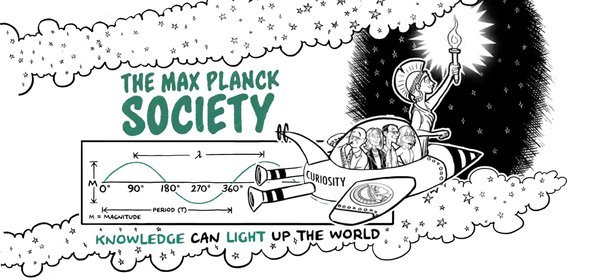
Max Planck Society
The Max Planck Society for the Advancement of Science (Max-Planck-Gesellschaft, MPG) is an independent, non-profit research organization. It was founded on February 26, 1948, and is the successor organization to the Kaiser Wilhelm Society, which was established in 1911.
The currently 86 Max Planck Institutes conduct basic research in the service of the general public in the natural sciences, life sciences, social sciences, and the humanities. Max Planck Institutes focus on research fields that are particularly innovative, or that are especially demanding in terms of funding or time requirements. And their research spectrum is continually evolving: new institutes are established to find answers to seminal, forward-looking scientific questions, while others are closed when, for example, their research field has been widely established at universities. This continuous renewal preserves the scope the Max Planck Society needs to react quickly to pioneering scientific developments.
Finance
The financing of the Max Planck Society is made up of 80% basic financing from the public sector: Including the MPI for Plasma Physics the MPG is financed to approximately 1,7 billion euros in 2018. In addition, third-party funding contributed to basic financing.
The German federal government together with the state governments each assume half of the funding for the budget of the Max Planck Society (budget A). The calculation of the financial contributions provided by the states is based on a distribution formula that is re-calculated each year as well as on the "home state quota", which has been steady at 50 percent since 2000. In addition, all partners may agree to provide extra funding in addition to the specified quotas.
The exception to this is the Max Planck Institute for Plasma Physics, which is funded by the German government and the states of Bavaria and Mecklenburg Western Pommerania in a ratio of 90:10 (budget B) in accordance with regulations for major research institutions. In addition, this institute receives subsidies from EURATOM for a joint research program within the scope of association agreements.
In addition to the grants provided by the German federal government and its states for institutional support, the Max Planck Society and its institutes receive project funding from the German government and state ministries, from the European Union, grants from private individuals, in the form of membership fees, donations and remuneration for services rendered.
Personnel
As of December 31, 2019, the Max Planck Society employed a total of 23.963 people (2017: 23.425), 6.887 of them scientists (2017: 6.772), which corresponds to 28.9% of the total workforce.
In addition, 2.120 guest scientists, 618 stipend holders and 1.668 student and research assistants conduct research at the 86 institutes of the MPG.
On December 31, 2019, the proportion of female employees was 44.1%. The percentage of female scientists was 16.4% at W3 level, 36.0% at W2 level and 32.6% at the level of scientists employed under the collective bargaining agreement for the public sector, while the percentage in non-scientific areas was 55.1%.
53.9% of the scientists have foreign citizenship and the total percentage of personnel from abroad is 32.8%.
As of January 1, 2015, the proportion of female employees was 44.8%; of these, around 31.6% were scientific employees and 55.9 % were non-scientific staff members. 29.8% of all of the employees were foreign nationals. Among the scientists, the proportion of those from abroad was 50,9 %
Knowledge Transfer
The Max Planck Society is a non-profit research organization which is why scientists at its institutes are obliged to make the results of their work accessible to the general public. This knowledge transfer occurs in a number of ways:
- Each year scientists and researchers at the Max Planck Society publish more than 12,000 scientific articles in renowned national and international scientific journals, databases, specialized textbooks, and reference books, etc.
- More than 9,000 junior scientists and researchers work at the institutes of the Max Planck Society. After completing their studies, they go on to assume responsible positions in business, politics, and society.
- New technical breakthroughs developed at Max Planck Institutes find application in the economy and in society as a result of cooperative efforts with industry, the granting of patents and licenses, and as a result of spin-off companies.
Since 1970, the Max Planck Society has maintained its own company to promote the transfer of technology. Max Planck Innovation (until the end of 2006 under the name of Garching Innovation) advises institutes on matters pertaining to the legal protection of industrial property. Max Planck Innovation does the necessary patent research, arranges legal counsel, and advises the researchers on patent registration procedures in Germany and abroad. In special cases, Max Planck Innovation approaches companies with inventions stemming from the institutes.